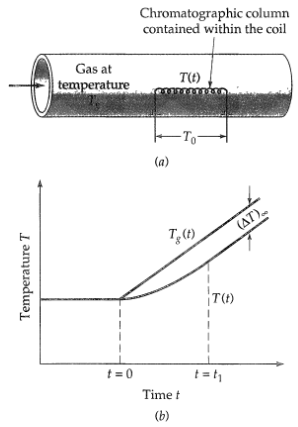Transient thermal behavior of a chromatographic device (Fig. 15B.7), you are a consultant to an industrial concern
Question:
Transient thermal behavior of a chromatographic device (Fig. 15B.7), you are a consultant to an industrial concern that is experimenting, among other things, with transient thermal phenomena in gas chromatography. One of the employees first shows you some reprints of a well-known researcher and says that he is trying to apply some of the researcher's new approaches, but that he is currently stuck on a heat transfer problem. Although the problem is only ancillary to the main study, it must nonetheless be understood in connection with his interpretation of the data and the application of the new theories.
A very tiny chromatographic column is contained within a coil, which is in turn inserted into a pipe through which a gas is blown to control the temperature (see Fig. 15B.7a). The gas temperature will be called Ts(t). The temperature at the ends of the coil (outside the pipe) is T0, which is not very much different from the initial value of T s. The actual temperature within the chromatographic column (i.e., within the coil) will be called T(t). Initially the gas and the coil are both at the temperature Ts0. Then beginning at time t = 0, the gas temperature is increased linearly according to the equation a Ts(t) = Tg0(1 + t/t0) where t0 is a known constant with dimensions of time. You are told that, by inserting thermocouples into the column itself, the people in the lab have obtained temperature curves that look like those in Fig. 15B.7 (b). The T(t) curve seems to become parallel to the Ts(t) curves for large t. You are asked to explain the above pair of curves by means of some kind of theory. Specifically you are asked to find out the following:
(a) At any time t, what will Tg – T be?
(b) What will the limiting value of Tg – T be when t →∞? Call this quantity (∆T) ∞.
(c) What time interval t1 is required for Tg – T to come within, say, 1% of (∆T) ∞?
(d) What assumptions had to be made to model the system?
(e) What physical constants, physical properties, and so on, have to be known in order to make a comparison between the measured and theoretical values of (∆T) ∞? Devise the simplest possible theory to account for the temperature curves and to answer the above five questions.

Step by Step Answer:






